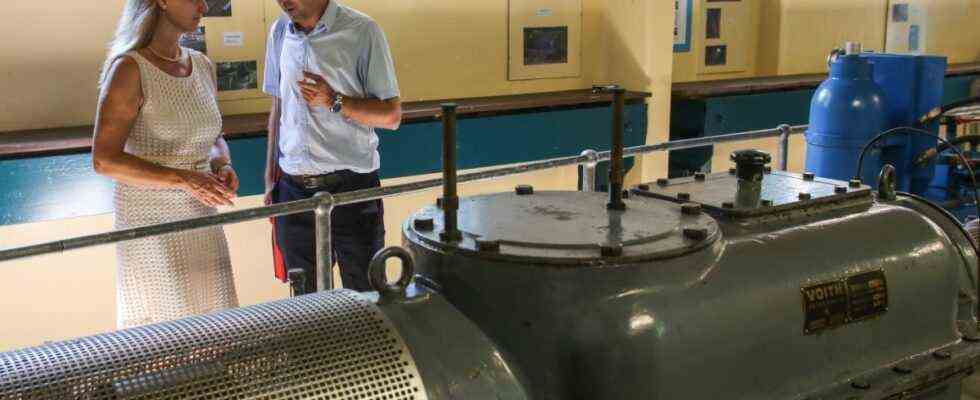It doesn’t always have to be hydropower from Norway or wind power from Northern Germany: There are also energy sources nearby that can ensure that the lights do not go out in Unterschleißheim and that the environment is also protected. Ever since James Eduard Haniel built the first hydropower plant in the castle park there in 1902, the neighboring community of Haimhausen in the Dachau district has been the location of an electricity supplier. At first the yield from the Amper Canal was enough for our own consumption, then further waterworks were built and since 2012 the family company has been supplying green electricity to customers all over Bavaria. Also in the neighboring Unterschleißheim. But the city is not one of them – not yet.
So far, Unterschleißheim has obtained its green electricity from another small supplier in the region, but one that cannot offer one thing: its own electricity production. The municipal works in Oberhaching secure – like many electricity providers – green electricity quotas on the electricity exchange. Where the electricity is actually produced in Europe is only a minor matter. The people of Oberhachingen obtain a large part of their green electricity from various hydropower plants in Europe. One of them is a barrage of the Arve river at the foot of the French Alps. In nominal terms, however, a power generation system can be ascribed to a consumer. According to the town hall, the electricity consumed by the city of Unterschleißheim comes from the Fosen Vind wind turbine in Norway, which went into operation in 2019.
The application by the Greens is aimed at suppliers such as E-Werke Haniel, who generate electricity from hydropower in Haimhausen, for example with a large power plant.
(Photo: Niels P. Joergensen)
Such attributions play a role if the customer attaches importance to the fact that with his green electricity he also contributes to the fact that the electricity provider not only uses old systems for his business, but also builds new systems or at least supports the expansion of renewable energies. It is currently unclear where the green electricity that the city of Unterschleißheim will get from in the future will come from. The city council has decided to put the expiring contracts with Oberhaching to tender for the coming year 2022. This expansion factor should then play a role again. It should be “green electricity with a quota of new plants”, in which at least half of the electricity supplied comes from new plants.
The outcome of the award is entirely written in the stars. Maybe Oberhaching will get back on track. Maybe another company. For the coming year, the city council has entrusted the organization of the tender to Kubus Kommunalberatung und Service GmbH. They have a free hand to get additional pantographs in order to make a so-called bundle tender so that in the end a cheaper offer comes out. Up to 300 municipalities or special-purpose associations can take part in such a tender. However, the Greens have now complained in the city council that small electricity suppliers like the Haimhauser, who generate their own electricity in the region, have bad cards with such an approach. These would certainly have to lose out in a bundle tender.
Electricity can also be generated with a water screw.
(Photo: Niels P. Joergensen)
Peter Müller is “Head of Customer Service” at E-Werke Haniel Haimhausen OHG. So far, he has not participated in any tender for the city of Unterschleißheim. “I would be happy,” he says. The idea is appealing and the project is basically not too big either. The amount of electricity for a city like Unterschleißheim can also be supplied. That is not the problem.
However, Peter Müller has often written offers for municipalities and has found in various tenders that in the end the calculation is tough and the price simply decides. Apart from that, Müller has to disappoint everyone who believes that the street lighting in Unterschleißheim and the dishwasher in a city daycare center can only be fed with electricity from an Amper river power station.
Because as small as the Haimhauser with their three and a half hydropower plants to be precise – there is also a water screw on the Mühlbach that supplies electricity for 20 households – they can basically supply almost unlimited electricity. Because Müller is also active on the electricity exchange. About 50 percent of the delivered quantities come from our own production, he says. Anything beyond that is bought in. In this respect, the small electricity supplier and electricity producers from the neighborhood do not differ that much from other suppliers. Nevertheless, the Greens pushed through in the city council that the town hall examines whether it makes sense to refrain from bundling with other customers in future tenders. That would be conceivable for the year 2023.
And would this strengthen the expansion of renewable energies in the region? Even Peter Müller from E-Werke Haniel cannot answer this question easily. In any case, the possibilities are limited. The power supplier in Haimhausen feels the same way as everyone else who wants to invest in renewable energy sources in the region. A further expansion of hydropower on the Amper would be good for Müller. But he doesn’t think that’s realistic. “You can’t really do anything anymore.” The conservationists didn’t play along. With large-area photovoltaic systems, especially with wind power, Müller experienced reservations in the population, which also prevented the Haniel electrical power plant from investing further in power generation systems.

